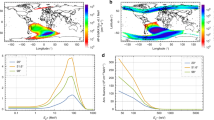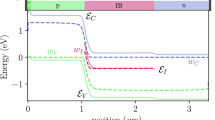Abstract
Developing electronic devices for space exploration requires understanding the response of the individual components to harsh environments including extreme temperatures and ionizing radiation. In this work, InAs-based devices were studied using multiscale computations. It was found that arsenide vacancies and arsenide anti-sites were the most energetically favorable point defects to form under indium-rich and indium-poor conditions, respectively, with the arsenide anti-site reducing the electron mobility by a factor of 10 at 300 K. Both defect types were found to introduce relatively deep charge transition levels in the band gap and mediate n-type conduction with ionization energies of 0.26 eV and 0.31 eV, respectively. Under indium-rich conditions, indium substitutional defects had comparable stability to the arsenide vacancies and introduced a shallow donor level with ionization energy of 0.03 eV and may play a role in n-type behavior in response to radiation damage. Indium vacancies were significantly less stable than other defects under all conditions and were the only defects to mediate p-type conduction by introducing shallow levels in the band gap. The Seebeck coefficient was found to increase monotonically from -5 × 10–4 V/K toward zero as the concentration of n-type dopants increased from 1015 to 1021 cm−3. The electrical conductivity was shown to increase dramatically by several orders of magnitude around doping concentration of 1020 cm−3 for both donors and acceptors. Finally, I–V characteristic curves showed dramatic increase of current in response to increase in temperature and radiation dose consistent with the available literature.




Similar content being viewed by others
Data availability
The raw data required to reproduce these finding can be made available upon reasonable request.
References
N.J. Quartemont, G. Peterson, C. Moran, A. Samin, B. Wang, C. Yeamans, B. Woodworth, D. Holland, J.C. Petrosky, J.E. Bevins, ATHENA: a unique radiation environment platform at the national ignition facility. Nucl. Instrum. Methods Phys. Res. A 1016, 165777 (2021). https://doi.org/10.1016/J.NIMA.2021.165777
A.J. Samin, J.C. Petrosky, An analysis of point defects in ZnTe using density functional theory calculations. J. Alloys Compd. 921, 166017 (2022). https://doi.org/10.1016/J.JALLCOM.2022.166017
A.J. Samin, D.A. Andersson, E.F. Holby, B.P. Uberuaga, On the role of electro-migration in the evolution of radiation damage in nanostructured ionic materials. Electrochem. Commun. 96, 47–52 (2018). https://doi.org/10.1016/j.elecom.2018.09.010
D.M. Fleetwood, E.X. Zhang, R.D. Schrimpf, S.T. Pantelides, Radiation effects in AlGaN/GaN HEMTs. IEEE Trans. Nucl. Sci. 69, 1105–1119 (2022). https://doi.org/10.1109/TNS.2022.3147143
A. Samin, M. Kurth, L. Cao, Ab initio study of radiation effects on the Li4Ti5O12 electrode used in lithium-ion batteries. AIP Adv. 5, 47110 (2015). https://doi.org/10.1063/1.4917308
J.H. Yang, L. Shi, L.W. Wang, S.H. Wei, Non-radiative carrier recombination enhanced by two-level process: a first-principles study. Sci. Rep. 26, 1–10 (2016). https://doi.org/10.1038/srep21712
A.M. Stoneham, Non-radiative transitions in semiconductors. Rep. Prog. Phys. 44, 1251 (1981). https://doi.org/10.1088/0034-4885/44/12/001
J.H. Song, H. Choi, H.T. Pham, S. Jeong, Energy level tuned indium arsenide colloidal quantum dot films for efficient photovoltaics. Nat. Commun. 9, 1–9 (2018). https://doi.org/10.1038/s41467-018-06399-4
Y. Park, S.Y. Bae, T. Kim, S. Park, J.T. Oh, D. Shin, M. Choi, H. Kim, B. Kim, D.C. Lee, J.H. Song, H. Choi, S. Jeong, Y. Kim, Charge-selective, narrow-gap indium arsenide quantum dot layer for highly stable and efficient organic photovoltaics. Adv. Energy Mater. 12, 2104018 (2022). https://doi.org/10.1002/AENM.202104018
D. Franke, D.K. Harris, O. Chen, O.T. Bruns, J.A. Carr, M.W.B. Wilson, M.G. Bawendi, Continuous injection synthesis of indium arsenide quantum dots emissive in the short-wavelength infrared. Nat. Commun. 7, 1–9 (2016). https://doi.org/10.1038/ncomms12749
M.S. Ram, K.M. Persson, A. Irish, A. Jönsson, R. Timm, L.E. Wernersson, High-density logic-in-memory devices using vertical indium arsenide nanowires on silicon. Nat. Electron. 4, 914–920 (2021). https://doi.org/10.1038/s41928-021-00688-5
P. Espinet-Gonzalez, E. Barrigón, G. Otnes, G. Vescovi, C. Mann, R.M. France, A.J. Welch, M.S. Hunt, D. Walker, M.D. Kelzenberg, I. Åberg, M.T. Borgström, L. Samuelson, H.A. Atwater, Radiation tolerant nanowire array solar cells. ACS Nano 13, 12860–12869 (2019). https://doi.org/10.1021/ACSNANO.9B05213/SUPPL_FILE/NN9B05213_SI_001.PDF
J.L. Autran, D. Munteanu, Atmospheric neutron radiation response of III–V binary compound semiconductors. IEEE Trans. Nucl. Sci. 67, 1428–1435 (2020). https://doi.org/10.1109/TNS.2020.2971611
J. Li, A. Aierken, Y. Liu, Y. Zhuang, X. Yang, J.H. Mo, R.K. Fan, Q.Y. Chen, S.Y. Zhang, Y.M. Huang, Q. Zhang, A brief review of high efficiency III–V solar cells for space application. Front. Phys. 8, 657 (2021). https://doi.org/10.3389/FPHY.2020.631925/BIBTEX
M. Imaizumi, Y. Okuno, T. Takamoto, S.I. Sato, T. Ohshima, T. Okamoto, Displacement damage dose analysis of alpha-ray degradation on output of an InGaP solar cell. Conf. Rec. IEEE Photovolta. Spec. Conf. (2020). https://doi.org/10.1109/PVSC45281.2020.9300777
G. Vizkelethy, E.S. Bielejec, B.A. Aguirre, Stochastic gain degradation in III–V heterojunction bipolar transistors due to single particle displacement damage. IEEE Trans. Nucl. Sci. 65, 206–210 (2018). https://doi.org/10.1109/TNS.2017.2772960
A. Barthel, L. Sayre, G. Kusch, R.A. Oliver, L.C. Hirst, Radiation effects in ultra-thin GaAs solar cells. J. Appl. Phys. 132, 184501 (2022). https://doi.org/10.1063/5.0103381/2837859
D. Ahmad Fauzi, N.K.A. Md Rashid, M.R. Mohamed Zin, N.F. Hasbullah, Neutron radiation effects on the electrical characteristics of InAs/GaAs quantum dot-in-a-well structures. IEEE Trans. Nucl. Sci. 62, 3324–3329 (2015). https://doi.org/10.1109/TNS.2015.2478450
X. Zhou, M. Gutierrez, C.H. Tan, X. Meng, L.G. Rojas, J.S. Ng, M. Robbins, N. Nelms, B. White, S. Zhang, Proton radiation effect on InAs avalanche photodiodes. Opt. Express 25, 2818–2825 (2017). https://doi.org/10.1364/OE.25.002818
M. Jiang, H. Xiao, S. Peng, L. Qiao, G. Yang, Z. Liu, X. Zu, First-principles study of point defects in GaAs/AlAs superlattice: the phase stability and the effects on the band structure and carrier mobility. Nanoscale Res. Lett. 13, 1–13 (2018). https://doi.org/10.1186/S11671-018-2719-7/TABLES/5
M. Jiang, H. Xiao, S. Peng, G. Yang, H. Gong, Z. Liu, L. Qiao, X. Zu, Ab initio molecular dynamics simulation of the radiation damage effects of GaAs/AlGaAs superlattice. J. Nucl. Mater. 516, 228–237 (2019). https://doi.org/10.1016/J.JNUCMAT.2019.01.030
A. Höglund, C.W.M. Castleton, M. Göthelid, B. Johansson, S. Mirbt, Point defects on the (110) surfaces of InP, InAs, and InSb: a comparison with bulk. Phys. Rev. B Condens. Matter Mater. Phys. 74, 075332 (2006). https://doi.org/10.1103/PHYSREVB.74.075332/FIGURES/8/MEDIUM
S. Krishnamurthy, Z.G. Yu, Theoretical study of native point defects in strained-layer superlattice systems. J. Appl. Phys. 123, 161414 (2018). https://doi.org/10.1063/1.5004176
Y. Gao, D. Sun, X. Jiang, J. Zhao, Point defects in group III nitrides: a comparative first-principles study. J. Appl. Phys. 125, 215705 (2019). https://doi.org/10.1063/1.5094356
N. Chen, D. Huang, E.R. Heller, D.A. Cardimona, F. Gao, Atomistic simulation of displacement damage and effective nonionizing energy loss in InAs. Phys. Rev. Mater. 5, 033603 (2021). https://doi.org/10.1103/PHYSREVMATERIALS.5.033603/FIGURES/11/MEDIUM
H.A. Tahini, A. Chroneos, S.T. Murphy, U. Schwingenschlögl, R.W. Grimes, Vacancies and defect levels in III–V semiconductors. J. Appl. Phys. 114, 063517 (2013). https://doi.org/10.1063/1.4818484
Q. Peng, N. Chen, D. Huang, E.R. Heller, D.A. Cardimona, F. Gao, First-principles assessment of the structure and stability of 15 intrinsic point defects in zinc-blende indium arsenide. Crystals 9, 48 (2019). https://doi.org/10.3390/CRYST9010048
G. Kresse, J. Furthmüller, Efficient iterative schemes for ab initio total-energy calculations using a plane-wave basis set. Phys. Rev. B 54, 11169–11186 (1996). https://doi.org/10.1103/PhysRevB.54.11169
G. Kresse, D. Joubert, From ultrasoft pseudopotentials to the projector augmented-wave method. Phys. Rev. B 59, 1758–1775 (1999). https://doi.org/10.1103/PhysRevB.59.1758
J.P. Perdew, K. Burke, M. Ernzerhof, Generalized gradient approximation made simple. Phys. Rev. Lett. 77, 3865–3868 (1996). https://doi.org/10.1103/PhysRevLett.77.3865
M. Yu, S. Yang, C. Wu, N. Marom, Machine learning the Hubbard U parameter in DFT+U using Bayesian optimization. Npj Comput. Mater. 6, 1–6 (2020). https://doi.org/10.1038/s41524-020-00446-9
D. Broberg, B. Medasani, N.E.R. Zimmermann, G. Yu, A. Canning, M. Haranczyk, M. Asta, G. Hautier, PyCDT: a Python toolkit for modeling point defects in semiconductors and insulators. Comput. Phys. Commun. 226, 165–179 (2018). https://doi.org/10.1016/J.CPC.2018.01.004
C. Freysoldt, J. Neugebauer, C.G. van de Walle, Fully Ab initio finite-size corrections for charged-defect supercell calculations. Phys. Rev. Lett. 102, 016402 (2009). https://doi.org/10.1103/PHYSREVLETT.102.016402/FIGURES/3/MEDIUM
G.K.H. Madsen, J. Carrete, M.J. Verstraete, BoltzTraP2, a program for interpolating band structures and calculating semi-classical transport coefficients. Comput. Phys. Commun. 231, 140–145 (2018). https://doi.org/10.1016/J.CPC.2018.05.010
J.E. Sanchez, DEVSIM: a TCAD semiconductor device simulator. J. Open Source Softw. 7, 3898 (2022). https://doi.org/10.21105/JOSS.03898
A. Fonari, C. Sutton, Effective Mass Calculator (2012). https://github.com/afonari/emc
W.M. Haynes, CRC Handbook of Chemistry and Physics, 97th edn. (CRC Press, 2016). https://doi.org/10.1201/9781315380476
A. Jain, S.P. Ong, G. Hautier, W. Chen, W.D. Richards, S. Dacek, S. Cholia, D. Gunter, D. Skinner, G. Ceder, K.A. Persson, Commentary: The materials project: a materials genome approach to accelerating materials innovation. APL Mater. 1, 011002 (2013). https://doi.org/10.1063/1.4812323
M. Zhu, Y. Ren, L. Zhou, J. Chen, H. Guo, L. Zhu, B. Chen, L. Chen, X. Lu, X. Zou, Temperature-dependent electrical characteristics of neutron-irradiated GaN Schottky barrier diodes. Microelectron. Reliab. 125, 114345 (2021). https://doi.org/10.1016/J.MICROREL.2021.114345
V.V. Kozlovski, A.A. Lebedev, M.E. Levinshtein, S.L. Rumyantsev, J.W. Palmour, Electrical and noise properties of proton irradiated 4H-SiC Schottky diodes. J. Appl. Phys. 123, 24502 (2018). https://doi.org/10.1063/1.5018043/151961
M. Turowski, T. Bald, A. Raman, A. Fedoseyev, J.H. Warner, C.D. Cress, R.J. Walters, Simulating the radiation response of GaAs solar cells using a defect-based TCAD model. IEEE Trans. Nucl. Sci. 60, 2477–2485 (2013). https://doi.org/10.1109/TNS.2013.2273446
M.M. Oo, N.K.A. MdRashid, J.A. Karim, M.R.M. Zin, N.F. Hasbullah, Neutron radiation effect on 2N2222 and NTE 123 NPN silicon bipolar junction transistors. IOP Conf. Ser. Mater. Sci. Eng. 53, 012013 (2013). https://doi.org/10.1088/1757-899X/53/1/012013
Acknowledgements
This work is supported by National Nuclear Security Administration under Grant NA000103. In addition, the authors would like to acknowledge allocations of computational resources from the Ohio Supercomputing Center (OSC).
Funding
This work was supported by the Department of Energy National Nuclear Security Administration grant NA000103.
Author information
Authors and Affiliations
Contributions
LRB: data collection, data analysis, and some writing; AJS: conceptualization, writing, and editing.
Corresponding author
Ethics declarations
Conflict of interest
The authors have no competing interests to report.
Additional information
Publisher's Note
Springer Nature remains neutral with regard to jurisdictional claims in published maps and institutional affiliations.
Rights and permissions
About this article
Cite this article
Brennaman, L.R., Samin, A.J. Insights into the performance of InAs-based devices in extreme environments from multiscale simulations. Appl. Phys. A 129, 480 (2023). https://doi.org/10.1007/s00339-023-06756-1
Received:
Accepted:
Published:
DOI: https://doi.org/10.1007/s00339-023-06756-1




